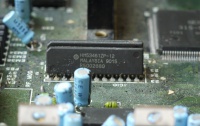Difference between revisions of "VRAM"
(Created page.) |
(Added info about 32X) |
||
| Line 1: | Line 1: | ||
| − | |||
VRAM is a memory segment on graphics systems in computers that is used to hold pattern data (for tiled VDPs) or bitmap data, in the case of a bitmap VDP. It is common for video adaptors to not map the video memory directly into I/O space, nor allow instant read/writes to it during active display. Most times, VRAM is DRAM or SDRAM, although in rare cases it may be SRAM or another variation of DRAM. | VRAM is a memory segment on graphics systems in computers that is used to hold pattern data (for tiled VDPs) or bitmap data, in the case of a bitmap VDP. It is common for video adaptors to not map the video memory directly into I/O space, nor allow instant read/writes to it during active display. Most times, VRAM is DRAM or SDRAM, although in rare cases it may be SRAM or another variation of DRAM. | ||
| Line 5: | Line 4: | ||
[[File:MD1VRAM.jpg|200px|thumb|right|The two µPD41264 graphics memories on a Model 1 [[Mega Drive]]]] | [[File:MD1VRAM.jpg|200px|thumb|right|The two µPD41264 graphics memories on a Model 1 [[Mega Drive]]]] | ||
The Mega Drive's VDP has 64 KB of dual-port graphics buffer memory. To get the required 8 bits of memory bandwidth, two µPD41264's are used in ZIP package, with addresses and control signals shared. The DRAM has two data ports, one for serial reading and a regular 4 bit random access port, a basic dual-port memory. The DRAM requires 256 (one per row) refresh cycles per 4 ms which is accomplished through /CAS before /RAS refresh. During active display, a limited number of access slots are available to the VRAM, one per 32 pixels. | The Mega Drive's VDP has 64 KB of dual-port graphics buffer memory. To get the required 8 bits of memory bandwidth, two µPD41264's are used in ZIP package, with addresses and control signals shared. The DRAM has two data ports, one for serial reading and a regular 4 bit random access port, a basic dual-port memory. The DRAM requires 256 (one per row) refresh cycles per 4 ms which is accomplished through /CAS before /RAS refresh. During active display, a limited number of access slots are available to the VRAM, one per 32 pixels. | ||
| + | |||
| + | == [[32X]] == | ||
| + | The 32X also has VRAM, but instead of being outputted depending on sprites, tiles, and so on, it is a simple [[framebuffer|framebuffer.]] All rendering for it has to be done in software, which is usually what one or both of the [[SH2]]'s are tasked with. The framebuffer can be put into various modes, allowing more colours, or a palette mode in which each pixel is an offset into a CRAM table. | ||
[[Category:Hardware]] | [[Category:Hardware]] | ||
Revision as of 12:11, 11 August 2012
VRAM is a memory segment on graphics systems in computers that is used to hold pattern data (for tiled VDPs) or bitmap data, in the case of a bitmap VDP. It is common for video adaptors to not map the video memory directly into I/O space, nor allow instant read/writes to it during active display. Most times, VRAM is DRAM or SDRAM, although in rare cases it may be SRAM or another variation of DRAM.
Mega Drive VDP VRAM

The Mega Drive's VDP has 64 KB of dual-port graphics buffer memory. To get the required 8 bits of memory bandwidth, two µPD41264's are used in ZIP package, with addresses and control signals shared. The DRAM has two data ports, one for serial reading and a regular 4 bit random access port, a basic dual-port memory. The DRAM requires 256 (one per row) refresh cycles per 4 ms which is accomplished through /CAS before /RAS refresh. During active display, a limited number of access slots are available to the VRAM, one per 32 pixels.
32X
The 32X also has VRAM, but instead of being outputted depending on sprites, tiles, and so on, it is a simple framebuffer. All rendering for it has to be done in software, which is usually what one or both of the SH2's are tasked with. The framebuffer can be put into various modes, allowing more colours, or a palette mode in which each pixel is an offset into a CRAM table.